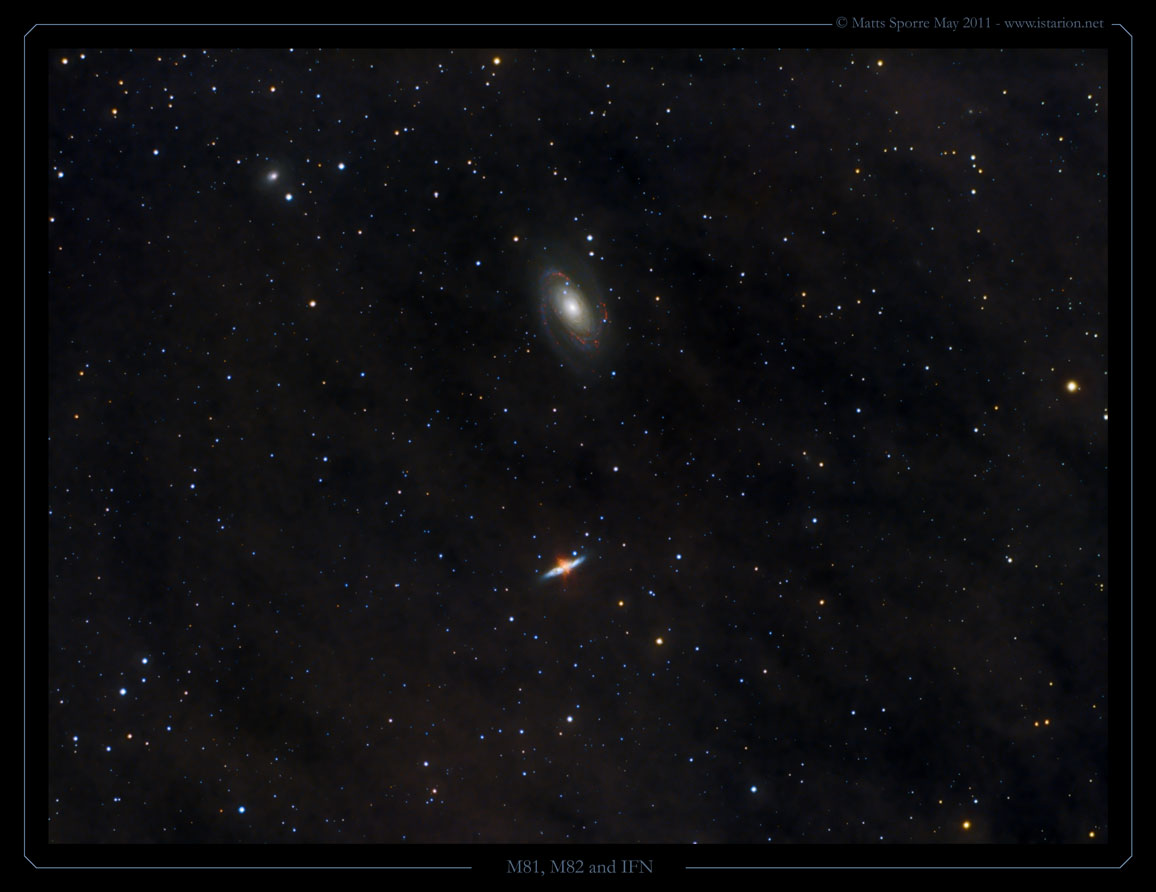Messier 81 (also known as NGC 3031 or Bode's Galaxy) is a spiral galaxy about 12 million light-years away in the constellation Ursa Major. Because of its proximity to Earth, its large size, and its active galactic nucleus (which harbours a 70 million M⊙ super massive black hole), Messier 81 is a popular galaxy to study in professional astronomy research. The galaxy's large size and relatively low apparent magnitude (lower magnitude implies higher brightness) also make it a popular target for amateur astronomy observations.
Messier 82 (also known as NGC 3034,
Cigar Galaxy or M82) is the prototype nearby starburst galaxy about 12
million light-years away in the constellation Ursa Major. The starburst
galaxy is five times as bright as the whole Milky Way and one hundred
times as bright as our galaxy's centre.
In 2005, the Hubble Space Telescope revealed 197 young massive clusters
in the starburst core. The average mass of these clusters is around
2×105 M⊙, hence the starburst core is a very energetic and high-density
environment. Throughout the galaxy's centre, young stars are being born
10 times faster than they are inside our entire Milky Way Galaxy.
The above text is taken from Wikipedia (M81 and M82).
By "mouse over" on the blue text just below the image you can see:
- Image details: Equipment used, number of subs etc.
Click here to view a 50% image.
This was the first time I tried the Baader RGB filters. As it turned out I had gotten the wrong red filter (to narrow) so I had to return it. While waiting the summer closed in putting an end to astrophotography her at 59 deg latitude. However I had a fair amount of Ha sub-exposures. During February - April my primary targets where H-alpha emission nebulas (The Soul, The Heart and The Monkey nebulas). They usually disappeared behind my house at roughly 1pm. Since there was still a few hours left to dawn I let the scope point at M81 and M82 and continued imaging.
The first two sessions with H-alpha also showed some promise in showing the IFN (Intergalactic Flux Nebula), which is dust in our own galaxy obscuring the view of M81 and M82. However on subsequent nights there was no more sign of the IFN in the H-alpha exposures. I guess that I had better than average seeing during these two nights. I have tried to use the background data for those first two sessions of H-alpha to construct a luminance (together with other images) in order to make the IFN show. Due to the little data aquired, I had to push the processing quite hard. Maybe I overdid it, but I just wanted to get some of that IFN visible.
The following software has been used. MaximDL (image acquisition and guiding), CCDStack (calibration and RGB scaling, PixInsight (cropping, background correction, colour corrections) and Photoshop CS5 (all the rest, incl Noel Carbonis Astronomy Tools), and finally JP Metsavainio's Tone Mapping technique.
This image was processed in March 2011
Copyright: All images © 2011 Matts Sporre. All Rights Reserved


